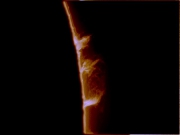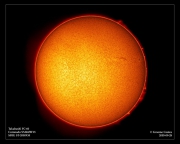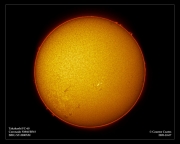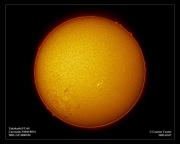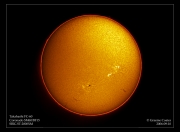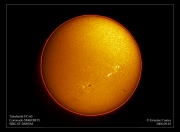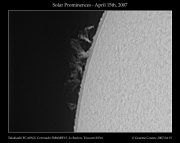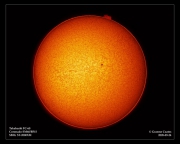 Continuing in the migration of my old site, here’s a post with a round up of my best h-alpha solar images. For a while, I owned a Coronado Solarmax 60 with BF15 blocking filter which I used to use on my Takahashi FC60NZ – I traded this more recently for the FLT110 – I found that I really wasn’t getting to use the h-alpha equipment for most of the year (work gets in the way when the sun is up!).
Continuing in the migration of my old site, here’s a post with a round up of my best h-alpha solar images. For a while, I owned a Coronado Solarmax 60 with BF15 blocking filter which I used to use on my Takahashi FC60NZ – I traded this more recently for the FLT110 – I found that I really wasn’t getting to use the h-alpha equipment for most of the year (work gets in the way when the sun is up!).
The h-alpha filter works by using an etalon to restrict the wavelengths of light as viewed through the telescope down to only a small region of the spectrum around 656.3nm (typically with a bandwidth of <0.7Å), which is a principal emission wavelength of excited hydrogen atoms (for the transition n=3 to n=2 in the Balmer series). This allows features such as prominences, flares, filaments and active regions to be observed, whereas in white light these are often not as noticable or are invisible.
My images were taken using either a Toucam Pro II webcam (for the closeups), or using the SBIG ST2000XM coupled with a Denkmeier Part O/Cell #150 relay lens combination to give the system enough backfocus to bring the camera to focus on the Takahashi FC60NZ. Note, for those of you with an SBIG camera taking very short images (milliseconds), you’ll want to check out SBIG’s Article on Vertical Streaking (.pdf)- you need to adjust a potentiometer in the back of the camera to avoid this happening!
The following gallery is a collection of images taken using the Coronado filter – there are more images of the sun in h-alpha during the 2005 Annular Eclipse.
![]() Solar H-Alpha Imaging Round Up by Graeme Coates is licensed under a Creative Commons Attribution-NonCommercial-ShareAlike 4.0 International License.
Solar H-Alpha Imaging Round Up by Graeme Coates is licensed under a Creative Commons Attribution-NonCommercial-ShareAlike 4.0 International License.
